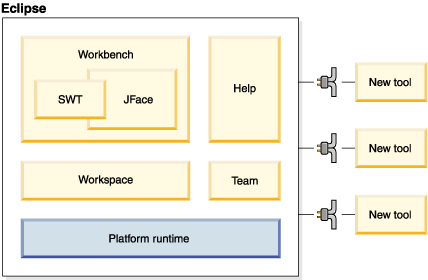

IBM Sales Center architecture
The IBM Sales Center architecture, when viewed in its entirety, contains the IBM Sales Center client, WebSphere Commerce Server, and a messaging architecture to allow for customization and extensibility.
This diagram illustrates the messaging architecture:

- The IBM Sales Center client performs a service request
- The service request handler prepares a Business Object Document message.
- The message is sent from the client to the host machine.
- The message mapper receives the message and maps the Business Object Document to a WebSphere Commerce BOD command.
- The WebSphere Commerce BOD command is invoked.
- The WebSphere Commerce BOD command calls a WebSphere Commerce Controller command, which may call one or more task commands.
- The reply or response builder constructs the response BOD.
- The response is returned to the client machine.
- The request handler receives and handles the response BOD.
- The client user interface is updated on screen.
IBM Sales Center and the rich client platform
The IBM Sales Center client is built on a rich client platform (RCP). This platform provides rapid development of integrated features based on a plug-in model. Plug-ins are structured components that use a manifest file (plugin.xml) in the Eclipse runtime system. The RCP combines the ease of management of a browser interface with the interactivity and performance of a client-server interface.
How it works
New tools interface with the RCP through a mechanism called a plug-in. Plug-ins are structured components which are configured using a manifest file (plugin.xml) in the Eclipse runtime system. For in-depth coverage of plug-ins, refer to the Eclipse platform documentation. The following diagram shows the five main components of the Eclipse platform:
 D
D
Each part of the Eclipse platform provides a way for developers to focus on their area of expertise, while maintaining an open, extensible architecture:
- The workbench, which includes Standard Widget Toolkit and JFace widgets, provides the user interface for your application.
- The help system provides browsable books created by extensible plug-ins.
- The workspace is the data model for your application, and provides an API for creating and managing Eclipse resources.
- Team features, such as repository management, are provided by Eclipse
- The platform runtime dynamically discovers and loads plug-ins and maintains information about the plug-ins and their extension points
For more information, refer to the Eclipse platform documentation. Each of the concepts described here is covered with exhaustive detail.
User Interface Overview
The following diagram shows the main layers of the user interface framework that supports the RCP:
 D
D
Workbench parts
- Editor parts
- Supports the editing or browsing of resources. They can only appear in one part of the page, but there can be many instances of a particular editor type open. Editors contribute buttons to the global toolbar of the workbench. Editors can also be associated with a file name or file extension.
- View parts
- Supports navigation of content from defined input. Views have a local toolbar, and can be minimized, maximized, or moved around the workbench page. Typically, there is one instance of a view per workbench page.
- JFace text framework
- Supports display and editing of source text
JFace UI Framework
- Viewers
- Support for building model-based visual parts with standard viewers.
- Actions and contributions
- Support for creating and managing shared resources such as the menu bar, the toolbar, and the status area
- Dialogs and wizards
- Single or multi-page dialogs that provide task guidance or value management. Note that by default, no wizards are included in the IBM Sales Center client.
- Images and fonts
- Support for construction and management of resources such as Standard Widget Toolkit (SWT) fonts and images
Standard Widget Toolkit (SWT)
A portable application programming interface to platform native widgets